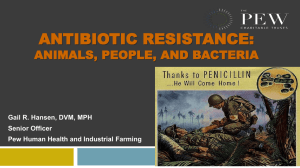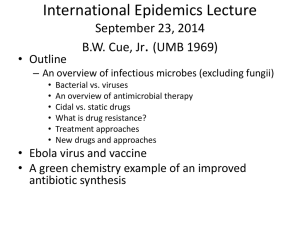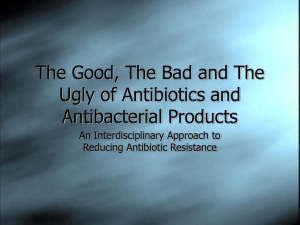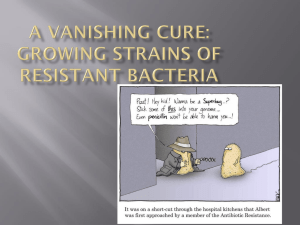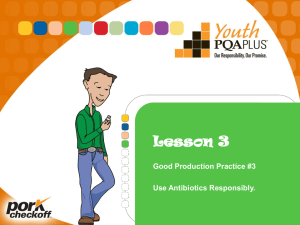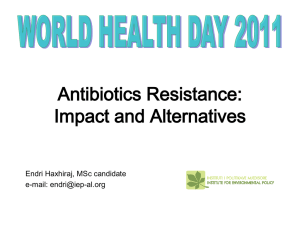Antibiotics Resistant Threats in the United States, 2013 (cont.)
advertisement
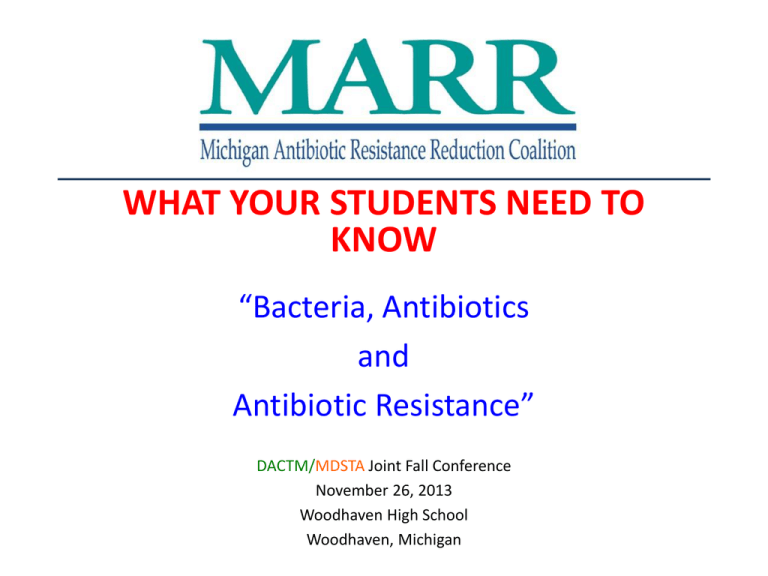
WHAT YOUR STUDENTS NEED TO KNOW “Bacteria, Antibiotics and Antibiotic Resistance” DACTM/MDSTA Joint Fall Conference November 26, 2013 Woodhaven High School Woodhaven, Michigan ANTIBIOTIC RESISTANT THREATS IN THE UNITED STATES, 2013 A Report by The Centers for Disease Control and Prevention • Report issued on September 16, 2013 using limited data collected from a variety of CDC programs and data from at least 10 states • “Threats” were assessed according to seven factors related to resistant infections: – Health impact – Economic impact – How common the infection is Antibiotics Resistant Threats in the United States, 2013 (cont.) – 10-year projection of how common it will become – How easily it spreads – Availability of effective antibiotics – Barriers to prevention Antibiotics Resistant Threats in the United States, 2013 (cont.) • Infections classified as urgent include: – Carbapenem-resistant enterbacteriaceae – Drug-resistant gonorrhea, and – Clostridium difficile Antibiotics Resistant Threats in the United States, 2013 (cont.) Key points to know: 1. Each year more than 2 million people in the U.S. get infections that are resistant to antibiotics and at least 23,000 people die. 2. C.difficile, usually associated with antibiotic use in hospitalized patients cause nearly 250,000 additional hospitalizations per year and result in over 14,000 deaths Antibiotics Resistant Threats in the United States, 2013 (cont.) 3. Patients with resistant infections are at higher risk of disability and death 4. Total economic cost of antibiotic resistance in the U.S. may be as high as $20 billion with additional loss of worker productivity resulting in a loss as high as $35 billion 5. Antibiotics are among the most commonly prescribed drugs, estimated that up to 50% Antibiotics Resistant Threats in the United States, 2013 (cont.) 5. (cont). of all antibiotics prescribed are not needed or not prescribed appropriately 6. As in humans, antibiotics should only be used in food animals to manage infections; not to promote growth or as a prophylactic Antibiotics Resistant Threats in the United States, 2013 (cont.) WHAT NEEDS TO BE DONE NOW • Rapid research and development of new antibiotics and anti-fungals • Increase collection of comprehensive data • Provide education about antibiotic resistance prevention and promote antibiotic stewardship Four core actions are needed • Prevent infections whenever possible • Track data on antibiotic-resistant infections, causes, and risk factors • Improve antibiotic stewardship – use targeted antibiotics whenever possible rather than broad spectrum drugs, use of regional antibiogram by primary care physicians • Development of new antibiotics and diagnostic tests to track the development of resistance ANTIBIOTIC RESISTANCE 10 National Antibiotic Prescribing CDC Abstract, 10/22/2010 11 What is the MARR Coalition? • The Michigan Antibiotic Resistance Reduction (MARR) Coalition is a multi-stakeholder, nonprofit organization • Supported by an annual, competitive grant from the CDC “Get Smart – Know When Antibiotics Work in the Community” • The MARR Mission is to: • Encourage appropriate use of antimicrobial agents • Reduce antimicrobial resistance rates through diverse collaboration in the public and professional communities • Promote appropriate use of antibiotics through educational programs and interventions 12 Community Education Let’s make it fun! • “Antibiotics and You” presentation for elementary students and adults • “High School Biology/Health” curriculum • Consumer education materials (“Antibiotics: What You Should Know” and “MRSA”, posters, fact sheets, FAQs) • MARR website: www.reducemisuse.org • Booths and Exhibits • “GET SMART” Antibiotics Awareness Week • Legislative education • Community speaking engagements © MARR Coalition 2013 H.S. Curriculum Content 13 MICHIGAN AND OREGON PROGRAMS COLLABORATE High School Curriculum Project • • What Tools Are Provided for Teachers? Developed by professional in state community health and education departments with the help of science teachers, physicians, nurses, pharmacists, and microbiologists Pre-packaged two-day curriculum modules: – Viruses and bacteria, – How antibiotics work – Development of antibiotic resistance – Environmental/Global impact © MARR Coalition 2013 H.S. Curriculum Content • • • • • • • 14 Materials on MARR website @: www.reducemisuse.org Instructional video for teacher PowerPoint presentations for students Pre and posttest for students Worksheet for students Resource information for interactive activities Report/evaluation PILOT OF CURRICULUM IN A MICHIGAN MATH AND SCIENCE CENTER • • • • Pilot with 11th and 12th graders Pre- and Post-test given Students knew most material in Module I Higher percentage of students did not know: – – – – – – – How bacteria can be beneficial to the body Body’s defenses to preventing bacteria from entering What an antibiotic is and how it works What is antibiotic resistance How bacteria mutate What is selective pressure How antibiotics can be acquired through the environment © MARR Coalition 2013 H.S. Curriculum Content 15 MICHIGAN SCIENCE CONTENT STANDARDS AND EXPECTATIONS – “BIOLOGY” • Scientific Reflection and Social Implications – B1.2 • Organization and Development of Living Systems – L2.p2, L2.p3, B2.1,B2.4, B2.4h, B2.4i • Interdependence of Living Systems and the Environment – L3.p1, L3.p2A, L3.p2B, L3.p2D, L3.p4A • Evolution and Biodiversity – L5.p1, B5.1A, B5.1cB B5.1c, B5.1d, B5.3g, B5.3A, B5.3f © MARR Coalition 2013 H.S. Curriculum Content 16 HOW DO I ACCESS THE CURRICULUM? • • • • • Go to the MARR website at: reducemisuse.org Click on: presenter/educator Click to go to Download Center Complete Registration Page Click your desired curriculum – “High School Biology/Health” curriculum – “Antibiotics and You”, elementary curriculum High School Biology/Health Curriculum for 9th and 10th grade students VIRUSES AND BACTERIA, ANTIBIOTIC DEVELOPMENT, AND ANTIBIOTIC RESISTANCE HIGHLIGHTS © MARR Coalition 2013 H.S. Curriculum Content Module One: What We Will Learn • What are microbes? • What are viruses? • What are bacteria? – Structure – Where do they live? • Bacteria and humans – – – – Bacterial identification Colonization Host cell defenses How bacteria cause infection © MARR Coalition 2013 H.S. Curriculum Content 19 Module Two: What We Will Learn • Antibiotics – How they work – How bacteria become resistant • Mutations in bacterial genes • Selection pressure (evolution) • Exchange of genetic material between bacteria • Strategies for overcoming antibiotic resistance in bacteria – Appropriate use – Research and development of new antibiotics © MARR Coalition 2013 H.S. Curriculum Content 20 Influenza Virus Structure N spike (neuraminidase) Lipid Envelope Matrix protein Nucleocapsid H spike (hemagglutinin) RNA © MARR Coalition 2013 2011222H.S. Curriculum Content Copyright © motifolio.com Viruses Invade Host Cells • Viruses lack some of the machinery to grow and reproduce by themselves • A virus invades a live host cell inside your body and starts replicating itself • The host cell releases the copied viruses • Each released virus will look for a new live host cell to invade and repeat the process Virus infecting a cell © MARR Coalition 2013 H.S. Curriculum Content Example of Bacterial Structure Cell (Cytoplasmic) membrane Ribosomes Pili Cell wall Flagella Plasmids Chromosome © MARR Coalition 2013 2711102 H.S. Curriculum Content Copyright © motifolio.com Today Antibiotic Timeline Some antibiotics don’t work anymore Way B.C. Bacteria were around before the dinosaurs Millions of years later 1920s 1940s President’s son dies from a bacterial infection The first antibiotics are made for humans 1950s Antibiotic resistance starts becoming a problem 2000s 2030 You are born! Will we have antibiotics that work? ? © MARR Coalition 2013 H.S. Curriculum Content 32 What is an Antibiotic? • A chemical that kills bacteria or stops them from growing • Antibiotics work only against bacteria, not viruses © MARR Coalition 2013 H.S. Curriculum Content 25 Selecting the Right Antibiotic For the Bacterial Infection *Bacteria are resistant to this antibiotic. • Bacteria grown in the lab are swabbed onto the surface of an agar culture plate • Filter paper disks containing different antibiotics are placed on the surface of the agar plate • The agar plate is incubated at body temperature overnight • An effective antibiotic is shown by a “clear zone” on the agar plate where the bacteria were inhibited Antibiotic by the antibiotic as it Bacteria from tissue diffused out from the *The “clear zone” around various antibiotics or fluid sample on this agar plate mean that these bacteria are disk susceptible to these various antibiotics.. © MARR Coalition 2013 H.S. Curriculum Content 26 I’M A LOCK! How Antibiotics Work If you think of bacteria as a lock, then an antibiotic is like a key © MARR Coalition 2013 H.S. Curriculum Content 27 I’M A KEY! Bacterial Lock and Antibiotic Key • Four things can happen: – The antibiotic key can unlock the bacteria and kill them – The antibiotic key can become damaged so it cannot open the bacterial lock – The bacterial lock can make slight changes so the key (antibiotic) no longer fits in the lock – The bacterial keyhole can become blocked so the antibiotic can not enter © MARR Coalition 2013 H.S. Curriculum Content 28 How Do Antibiotics Fight Bacteria? • Antibiotics disrupt a specific function of a bacterium, preventing its growth and replication by: – interfering with DNA or RNA replication – disrupting the production of the bacterial cell wall – preventing the production of proteins and smaller molecules that are necessary for growth and replication – Dissolving the cell membrane, causing leakage of cytoplasmic contents © MARR Coalition 2013 H.S. Curriculum Content 29 Key Concepts to Remember About Antibiotics • A newly developed antibiotic is most effective when it is first released for human treatment, since later use will inevitably select resistant bacteria • Today some bacteria have developed multidrug resistance, and, in some cases, bacteria are resistant to all available antibiotics • Over time, even fewer antibiotics will be effective, unless newer ones can be developed to replace them • The development of new antibiotics has slowed, primarily due to development cost and lower financial incentive, since the income from an antibiotics taken for 10 days is less than from drugs that are prescribed for lifetime use (e.g., antihypertensive drugs, cholesterol-lowering drugs) © MARR Coalition 2013 H.S. Curriculum Content 30 How Does Resistance Develop? I. Mutations in resistance genes in bacteria II. Transfer of genetic material from resistant bacteria to susceptible bacteria III. Selective pressure (the preservation of resistant cells while susceptible cells are killed (e.g., evolution) © MARR Coalition 2013 H.S. Curriculum Content 31 Selective Pressure • The presence of an antibiotic selects the growth of an organism that has become resistant by mutation or acquiring new DNA. • Mechanisms include: – Patient non-compliance (only taking for a few days or skipping doses) – Inadequate dosing (dose to low, or doses spaced too far apart) – Misuse of antibiotics Overuse (prescribing when not needed) Inappropriate use (patient taking antibiotics prescribed for a different infection) Unnecessary use of broad-spectrum antibiotic (exposing patient to a drug that can affect colonizing bacteria elsewhere in the body) © MARR Coalition 2013 H.S. Curriculum Content 32 Selection for Resistance Sensitive and resistant bacteria live together. © MARR Coalition 2013 H.S. Curriculum Content Antibiotics kill sensitive bacteria. The resistant bacteria are left to multiply. 33 Important Things to Remember About Antibiotics Bacteria Viruses • Antibiotics kill bacteria, not viruses. XX • Taking an antibiotic unnecessarily for colds and flu can select bacteria in the body that are resistant to Does not the antibiotic. work Antibiotics • Never save or share your antibiotics. • Take your antibiotics as prescribed by your care provider. © MARR Coalition 2013 H.S. Curriculum Content 34 Why Should We Be Concerned About Antibiotic Resistance? • Antibiotic resistance is a serious global problem • Resistant infections are difficult to treat – the bacteria may be resistant to multiple types of antibiotics • Resistance limits the range of effective antibiotics, sometimes leaving only antibiotics that are expensive, inconvenient to use, or even dangerous (toxic) © MARR Coalition 2013 H.S. Curriculum Content 35 Additional Environmental Concerns • Antibiotics are being used to treat meat animals and poultry to prevent infections rather than to treat them, and to promote faster growth; this excessive antibiotic usage can lead to selection of antibiotic resistant bacteria which can get into humans, either from close contact or consumption of infected meat or dairy products • Improper disposal of old or unused antibiotics can pollute the water supply, exposing the general public to low levels of antibiotics which can select for resistance in colonizing bacteria © MARR Coalition 2013 H.S. Curriculum Content 36 Preventing Bacterial Infection is the Best Medicine! • Wash your hands properly – Before eating – After using the bathroom – After a sneeze or cough • Cover coughs and sneezes • Help your immune system by: – Eating healthy foods – Exercising regularly – Getting plenty of sleep every night • NEVER take an antibiotic for a viral infection, like a cold or flu © MARR Coalition 2013 H.S. Curriculum Content 37 What Else Can You Do? • If you are prescribed antibiotics, take all of the medication as prescribed by your care provider • Do not stop taking an antibiotic before the end of the treatment course just because you start to feel better; residual bacteria may multiply, causing recurrence of symptoms that may require retreatment increasing the likelihood of selecting resistant cells • Never share or save antibiotics • Spread the word, not the resistance © MARR Coalition 2013 H.S. Curriculum Content 38 WHAT MARR HOPES TO ACHIEVE THROUGH EDUCATIONAL CURRICULUM • An applicable knowledge for students about the seriousness of antibiotic resistance – How bacteria is spread – How it is treated – Why it is important to take antibiotics only when and as prescribed by a professional – What is antibiotic resistance • How to preserve antibiotics for the future © MARR Coalition 2013 H.S. Curriculum Content High School Biology/Health and Elementary School Curriculum Now Available Download at: www.reducemisuse.org For More Information Contact: Jane Finn, MARR Executive Director 517-664-5263 jane@mi-marr.org © MARR Coalition 2013 H.S. Curriculum Content 40


